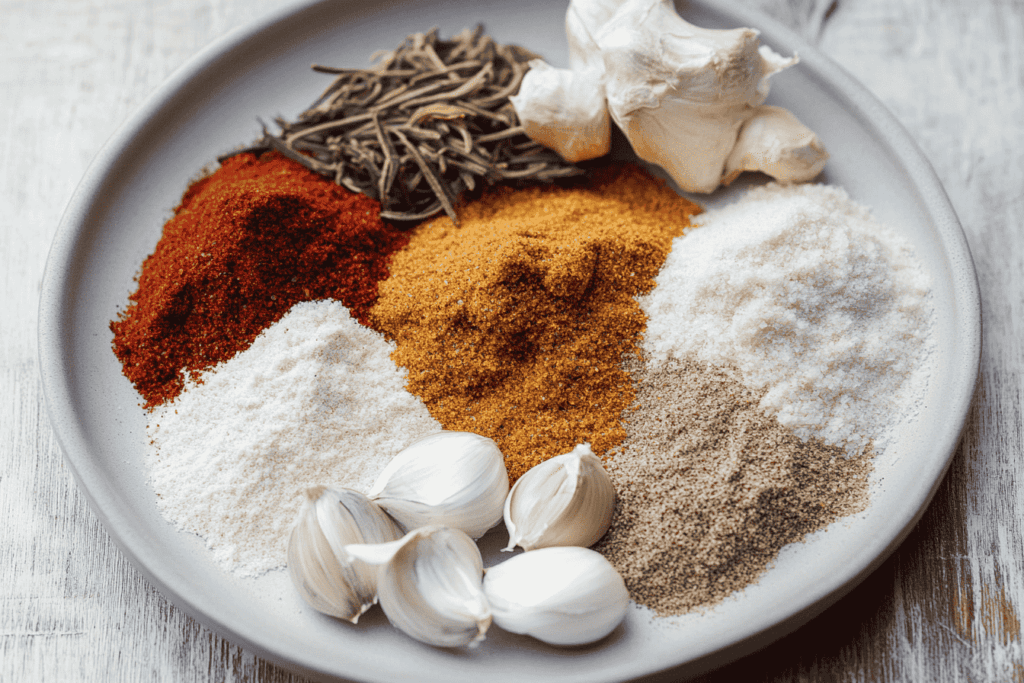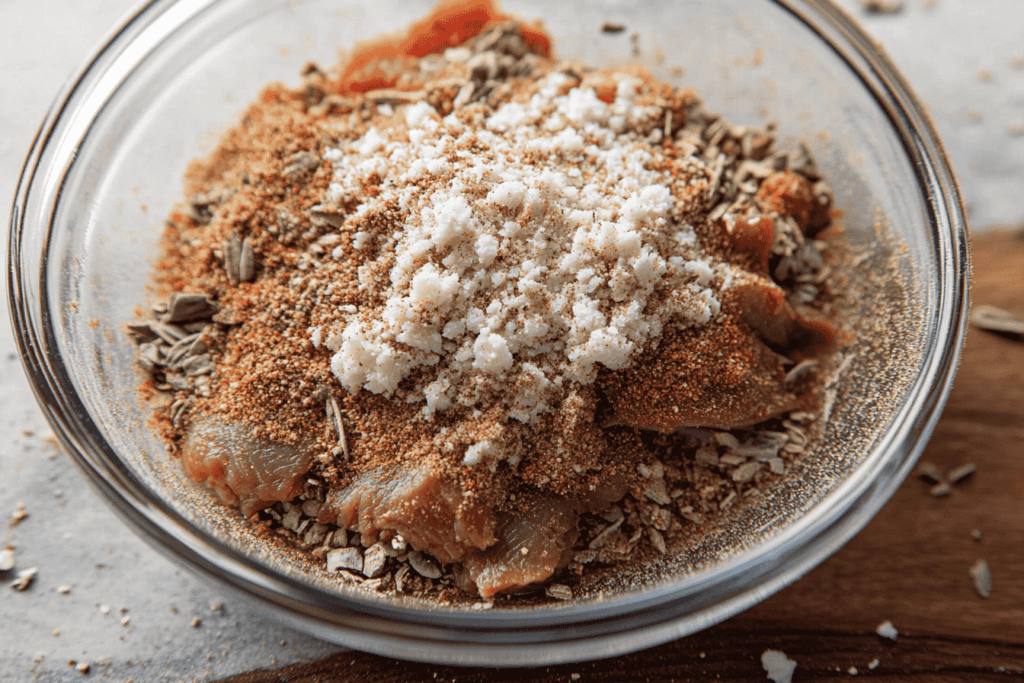A delicious stew starts with the right beef stew seasoning to bring out rich, hearty flavors in every bite. Whether you’re simmering a pot for hours or using a slow cooker, the right blend of herbs and spices makes all the difference. From classic mixes like thyme and paprika to custom homemade spice blends,this seasoning transforms simple ingredients into a warm, comforting meal.
Ready to dive into the flavorful world of beef stew seasoning? Let’s get started!
Table of Contents
What is Beef Stew Seasoning?
Definition and Purpose
Beef stew seasoning is a savory blend of herbs and spices specifically curated to enhance the deep, rich flavors of beef stew. It’s not just about salt and pepper—this mix balances earthy, aromatic, and sometimes slightly sweet or spicy notes that bring life to your dish.
Imagine tender beef chunks slow-cooked in a broth filled with the essence of rosemary, thyme, paprika, and garlic. That burst of flavor? Yep, that’s the magic of beef stew seasoning! Its purpose is simple—transform ordinary ingredients into a cohesive, mouthwatering stew that tastes like it’s been simmering in flavor for hours.
For a health-conscious twist, consider pairing your stew with nutrient-rich ingredients like those found in this natural Mounjaro recipe, which can complement your meal with wholesome, natural elements.
Brief History and Cultural Relevance
While beef stew has been around for centuries (because honestly, who doesn’t love stewed meat?), the art of seasoning evolved regionally. French stews often lean on herbes de Provence, while American stews might get a smoky kick from paprika and cayenne. Across the globe, different cultures have their own take on stew seasoning—proof that flavor knows no boundaries.
The development of modern beef stew spice mixes reflects this cultural melting pot, combining classic herbs like bay leaves and thyme with onion powder, black pepper, and cumin. Today, you can find ready-made packets on store shelves or whip up a homemade mix that speaks to your taste buds.
Why Seasoning is Essential for Beef Stew
Let’s get real—beef stew without seasoning is just a pot of boiled meat and veggies. Not exactly inspiring, right? Seasoning is what makes the difference between a bland stew and one that hits you with warmth, depth, and complexity in every bite.
Beef stew seasoning isn’t just about taste. The herbs and spices also help tenderize the meat, infuse the broth with character, and give the dish those comforting, nostalgic flavors we crave during colder months. Plus, the right mix can add color, aroma, and a balanced punch to every spoonful.
In short, don’t skip the seasoning—it’s the soul of your stew!
Key Ingredients in Beef Stew Seasoning
Essential Herbs
Store-bought beef stew seasoning can save time, but creating your own blend brings out deeper, more complex flavors.
- Thyme – This herb is a staple in beef stews. Its earthy and slightly minty flavor melds beautifully with the richness of beef. A pinch of dried thyme early in the cooking process creates a robust base.
- Rosemary – Bold and fragrant, rosemary adds a pine-like aroma that complements the hearty nature of stews. It works wonders when paired with root vegetables and tender beef chunks.
- Parsley – While often overlooked, parsley brings a bright, slightly peppery kick to balance out heavier spices. Fresh or dried parsley can be sprinkled in during the last few minutes of cooking.
- Bay Leaves – A classic in almost every stew recipe, bay leaves infuse a subtle bitterness and complexity that enhances the flavor depth. Don’t forget to fish them out before serving!
These herbs are essential to laying the groundwork for a stew that tastes like it’s been simmering for hours, even if you’re pressed for time.
Must-Have Spices

Herbs lay the foundation, but spices bring the heat and depth that make your stew unforgettable.
- Black Pepper – Freshly ground black pepper adds a spicy, slightly floral bite without overpowering the dish. It works in harmony with other spices to give the stew a rounded heat.
- Paprika – A splash of paprika not only boosts flavor but adds color. Use smoked paprika for a rich, smoky undertone or sweet paprika for a milder touch.
- Cumin – Cumin offers a warm, nutty flavor that pairs exceptionally well with beef. It introduces a subtle smoky profile that adds depth without being overpowering.
- Garlic Powder – Garlic powder provides a pungent, savory taste. For an extra kick, add fresh garlic cloves alongside the powder.
- Onion Powder – A key player in enhancing umami flavors, onion powder helps round out the seasoning blend with a mellow sweetness.
Flavor Enhancers
A great seasoning mix benefits from a few finishing touches:
- Salt – Essential for unlocking flavors, salt enhances the taste of every ingredient. Be mindful of how much you use, especially if your broth already contains sodium.
- Crushed Red Pepper Flakes – A sprinkle of red pepper flakes introduces a gentle heat that lingers on the palate.
- Brown Sugar – A small amount of sugar balances out the acidity in tomato-based stews and adds a hint of sweetness to the savory mix.
Together, these ingredients form a perfect balance of savory, sweet, and spicy, resulting in a stew that’s flavorful from the first spoonful to the last.
How to Make Your Own Beef Stew Seasoning
Homemade Seasoning Recipe
Why rely on store-bought when you can customize your own beef stew seasoning at home? Crafting a homemade mix not only saves money but also allows you to tweak the flavors to your liking.
Ingredients:
- 2 tablespoons dried thyme
- 2 tablespoons dried rosemary
- 2 tablespoons dried parsley
- 1 tablespoon black pepper
- 2 teaspoons paprika (smoked or sweet)
- 2 teaspoons cumin
- 1 teaspoon garlic powder
- 1 teaspoon onion powder
- 1 to 2 teaspoons salt (adjust to taste)
- ½ teaspoon crushed red pepper flakes (optional)

Instructions:
- Combine all ingredients in a bowl.
- Stir well to ensure even distribution of herbs and spices.
- Store the blend in an airtight container in a cool, dark place.
- Use 2 to 3 tablespoons per pot of stew, adjusting to taste.
This DIY beef stew seasoning recipe not only enhances the flavor of stews but can be used for roasts, soups, and even marinades.
Adjusting for Different Flavor Profiles
Want to mix things up? Play around with the ratios:
- Add extra paprika for a sweeter, more vibrant stew.
- Toss in more cumin for a smoky, Middle Eastern twist.
- Skip the salt entirely for a low-sodium blend.
The beauty of homemade seasoning is that it’s endlessly adaptable.
Customizing to Dietary Needs
For those watching their sodium intake or avoiding preservatives, homemade seasoning is a game-changer. You control what goes in—no hidden MSG or artificial flavors. Plus, it’s gluten-free and can easily be made organic by selecting high-quality herbs and spices.
Experiment, taste, and tweak until you’ve created the perfect beef stew seasoning that reflects your palate. After all, the best stew is the one that tastes exactly how you like it.
The secret to unforgettable stews often lies in using the right beef stew seasoning blend of herbs and spices.
Best Store-Bought Beef Stew Seasoning Mixes
Top 5 Store-Bought Brands
If making your own mix isn’t your thing or you’re short on time, there’s no shame in grabbing a pre-made beef stew seasoning from the store. In fact, some of the top brands deliver rich, savory flavors that rival homemade blends.
Here are the top five picks that consistently earn rave reviews:
- McCormick Slow Cooker Hearty Beef Stew Seasoning – A crowd favorite for its balanced blend of spices and herbs, perfect for slow-cooked meals.
- Watkins Organic Beef Stew Seasoning – Certified organic and free of artificial ingredients, this mix brings a clean, rich flavor to your stew.
- Lawry’s Beef Stew Seasoning Mix – Known for its bold, slightly peppery kick, Lawry’s blend complements hearty vegetables and tender beef.
- Happy Belly (Amazon Brand) Beef Stew Seasoning – A budget-friendly option that still packs a flavorful punch, great for quick weeknight dinners.
- Crock-Pot Hearty Beef Stew Mix – Specifically designed for slow cookers, this seasoning enhances the natural flavors of beef and vegetables.
Comparison of Ingredients and Flavor Profiles
While most store-bought blends contain thyme, garlic powder, and paprika, the flavor intensity varies. For a deeper, smoky flavor, look for mixes that include smoked paprika or cumin. If you prefer a milder, sweeter stew, choose blends with onion powder and brown sugar.
Pros and Cons of Pre-Made Mixes
Pros:
- Convenient and quick
- Consistent flavor every time
- No need to measure or mix
Cons:
- Often contain preservatives or added salt
- Less control over flavor customization
If you love experimenting, you can always enhance store-bought seasoning by adding extra garlic, fresh herbs, or a splash of red wine.
For more delicious dinner ideas, try our tender and flavorful beef back ribs recipe. If you’re in the mood for something quicker, our juicy beef brisket sandwich makes the perfect lunch option.
How to Use Beef Stew Seasoning
Don’t forget to sprinkle extra beef stew seasoning towards the end to enhance the overall taste. If you love bold flavors, try pairing your stew with our famous beef brisket sandwich – perfect for a hearty lunch.
When to Add Seasoning
Timing is everything when it comes to beef stew seasoning. Add your seasoning mix early in the cooking process, preferably after browning the meat but before adding the liquid. This allows the spices to toast slightly, deepening their flavors.
As the stew simmers, the seasoning melds with the broth, resulting in a rich, flavorful dish. However, for fresh herbs like parsley or thyme, it’s best to sprinkle them in during the last 10 minutes of cooking to preserve their bright, fresh taste.
Quantity to Use for Optimal Flavor
Wondering how much seasoning to add? A good rule of thumb is 2 to 3 tablespoons of beef stew seasoning per pot (around 4-6 servings). Start small—you can always add more, but it’s tough to dial back once the flavor is too strong.
Taste as you go. If the stew needs a little something extra, sprinkle in more seasoning halfway through cooking. Remember, the longer the stew simmers, the more pronounced the flavors become.
Enhancing Flavor Through Cooking Techniques
Want to take your stew to the next level? Try these tricks:
- Sear the Meat First – Browning your beef with a pinch of seasoning creates a flavorful crust that intensifies the stew.
- Deglaze the Pan – After searing, pour a splash of red wine or beef broth into the pan, scraping up those tasty bits of flavor.
- Layer the Seasoning – Season in stages—when browning the meat, while simmering, and right before serving. This ensures well-rounded, layered flavors.
Tips for Perfecting Beef Stew Flavor
Balancing Spices and Herbs
Experimenting with different types of beef stew seasoning allows you to tailor each dish to your liking
Creating the perfect beef stew seasoning isn’t just about tossing in spices and hoping for the best. Balance is key. Too much cumin can overpower the dish, while not enough salt leaves it bland. The goal is to layer flavors, allowing each ingredient to shine without dominating the pot.
Start with classic base herbs like thyme and rosemary, then build with paprika, black pepper, and garlic powder. If the stew tastes flat, try adding a splash of acidic ingredients like tomatoes or red wine. For sweetness, a pinch of brown sugar works wonders.
Remember, spices can intensify as they cook, so err on the side of caution. Taste as the stew simmers and adjust along the way.
Pairing Seasoning with Additional Ingredients
The beauty of beef stew seasoning is how well it complements other ingredients. Root vegetables like carrots and potatoes soak up the flavors, while mushrooms and onions add depth. For a heartier profile, try tossing in parsnips or turnips.
Don’t forget the liquid base—beef broth, tomato paste, or even beer can enhance the richness of the stew. Pairing your seasoning with the right ingredients creates a dish that’s not just delicious but layered with complexity.
If you’re feeling adventurous, add a sprinkle of red pepper flakes or smoked paprika for a subtle kick.
FAQs – Beef Stew Seasoning
What is the best seasoning mix for beef stew?
The best beef stew seasoning often combines thyme, rosemary, paprika, garlic, and black pepper. Brands like McCormick and Lawry’s offer excellent blends, but a homemade mix lets you control the flavors to match your preferences.
Can I make beef stew seasoning without salt?
Absolutely! Crafting a salt-free blend is simple. Focus on herbs and spices like onion powder, cumin, and paprika. Add salt separately to suit your taste, ensuring full control over sodium levels.
What herbs should I avoid in beef stew seasoning?
Avoid herbs with overpowering flavors that might clash with beef, like mint or tarragon. Stick to earthy, woody herbs that enhance, not mask, the natural flavors of the stew.
How can I thicken beef stew while maintaining flavor?
To thicken your stew, mix a tablespoon of flour or cornstarch with water and stir it in during the final 20 minutes. Alternatively, mashing a few potatoes directly into the broth can create a thicker texture without diluting the beef stew seasoning flavors.
Is it better to use fresh or dried herbs?
Both have their place. Dried herbs are concentrated and perfect for slow cooking, while fresh herbs add brightness when sprinkled in at the end. For the best of both worlds, use dried herbs early and garnish with fresh ones before serving.
Conclusion – Mastering Beef Stew Seasoning
Beef stew seasoning is the secret weapon that transforms simple ingredients into a mouthwatering, hearty meal. Whether you craft a homemade mix or grab a trusted store-bought option, the right combination of herbs and spices brings out the best in your stew.
By understanding the essential components—thyme, rosemary, paprika, and black pepper—and layering flavors throughout the cooking process, you can elevate your stew to restaurant-quality levels. Experiment with different ingredients, trust your palate, and don’t be afraid to adjust seasoning as you go.
Remember, the perfect beef stew seasoning reflects your unique taste. Whether you prefer a smoky, spicy profile or a milder, herb-driven blend, the key is finding the balance that works for you.
Now that you’re equipped with seasoning know-how, why not put it to the test? Grab your pot, gather your spices, and start simmering a stew that will have everyone asking for seconds! And if you’re looking for morning inspiration, browse our breakfast recipes for easy and flavorful options.
For the best results, pair your beef stew seasoning with fresh vegetables and tender cuts of beef.

